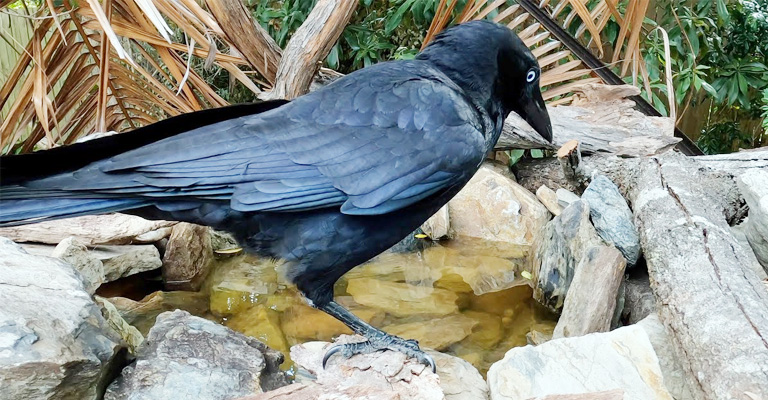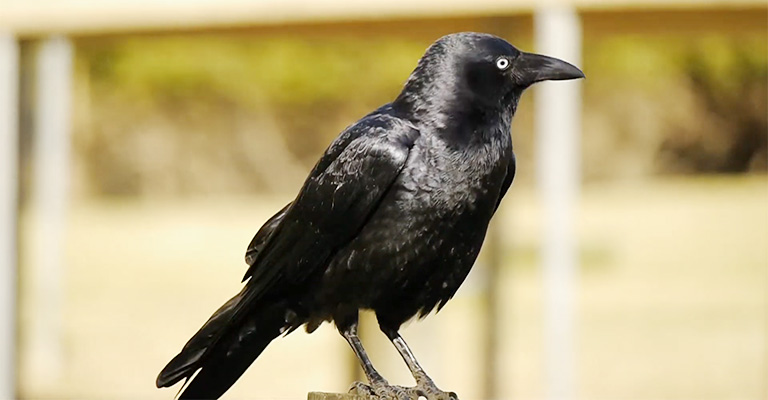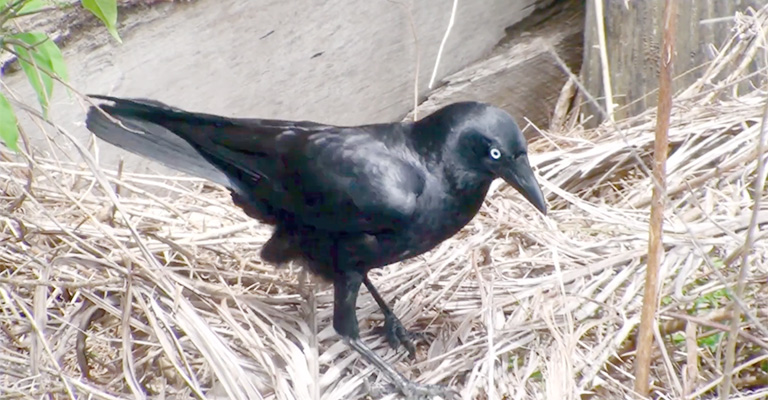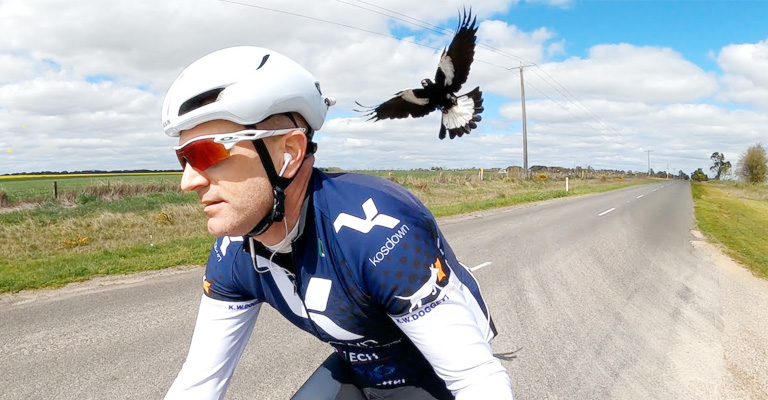Encounters with swooping Torresian Crows can be both startling and unnerving, especially during their breeding season when these birds become fiercely protective of their nests and territories.
While their aerial assaults are primarily defensive in nature, it’s crucial to know how to defend yourself without causing harm to these intelligent creatures.
In this blog post, we will delve into the question ‘How to defend against swooping Torresian crow?’. From understanding their behavior to employing non-confrontational deterrents, we’ll provide you with a comprehensive guide on staying safe while enjoying the great outdoors.
Whether you’re a cyclist, jogger, or simply someone who frequents areas inhabited by these birds, the tips and insights shared here will help you navigate swooping crow hotspots with confidence. Stay focused.

Torresian Crow Behavior
The Torresian Crow, scientifically known as Corvus, is a widespread and intelligent bird species found in various parts of Australia and nearby regions.
These crows exhibit fascinating behavior, reflecting their adaptability and resourcefulness. Here are some points elaborating on Torresian Crow behavior:
Social Structure
Torresian Crows typically form tight-knit social groups, often consisting of family members. These groups collaborate on various tasks such as foraging, predator defense, and territory maintenance. Within these groups, they establish a clear hierarchy, with dominant individuals having priority access to resources.
Vocalizations
These crows are known for their diverse and intricate vocalizations. They use a wide range of calls to communicate with each other, including warning calls for predators, specific calls during feeding, and even mimicry of other bird species.
Their vocal repertoire allows them to convey complex information within their social groups.
Nesting and Breeding
Torresian Crows are monogamous birds and form long-term pair bonds. They construct sturdy nests made of sticks, usually high in trees for protection.
During the breeding season, both the male and female participate in nest-building and incubating eggs. Their strong family bonds extend to raising and protecting their chicks.
Dietary Habits
These crows are opportunistic omnivores, displaying a varied diet. They feed on insects, small vertebrates, fruits, seeds, and even carrion. Their adaptability to a wide range of food sources has contributed to their survival in different environments.
Tool Use
Torresian Crows are renowned for their problem-solving abilities and tool-use skills. They have been observed using sticks, leaves, and even their own feathers as tools to extract insects from tree bark or crevices. This innovative behavior showcases their intelligence and adaptability.
Territorial Defense
Torresian Crows are territorial birds, vigorously defending their nesting sites and feeding areas from intruders. They engage in mobbing behavior when faced with potential threats, working together to drive away larger predators like raptors and monitor lizards.
Urban Adaptation
One of the most remarkable aspects of Torresian Crow behavior is their successful adaptation to urban environments.
They have learned to exploit human-made structures and resources, such as scavenging from garbage bins and using power lines as perches. Their adaptability to urbanization highlights their ability to thrive in changing landscapes.
Torresian Crows are highly social, adaptable, and intelligent birds that exhibit a wide range of behaviors, from complex vocalizations and tool use to family-oriented nesting and territorial defense.
How to Defend Against Swooping Torresian Crow?

Defending against swooping Torresian Crows can be a challenge, especially during their breeding season when they become more protective of their nests and territories. Here are some strategies to help you avoid and defend against swooping Torresian Crows:
Awareness
It’s crucial to stay well-informed about the habits and behavior of Torresian Crows, especially during their breeding season, which generally spans from August to November. During this period, these birds can become particularly territorial and aggressive in defense of their nests and young.
To stay safe, make use of resources provided by local authorities or online platforms that compile information on known swooping hotspots.
These resources can help you identify areas with higher crow activity, allowing you to exercise extra caution when passing through such zones.
Avoidance
One of the most effective strategies to minimize the risk of encountering swooping Torresian Crows is avoidance. If you’re aware of areas where these birds are known to nest or swoop, it’s wise to plan alternative routes to your destination.
This proactive approach reduces the likelihood of unexpected encounters, offering a safer and less stressful journey. By steering clear of their nesting zones, you’ll also contribute to the birds’ peace and security during their breeding season.
Wear Protective Gear
When venturing into crow-prone areas, consider equipping yourself with protective gear. A wide-brimmed hat or carrying an umbrella can serve as both physical barriers and deterrents.
These items create a larger and less appealing silhouette, which can dissuade crows from swooping. The hat or umbrella can act as a shield, providing a sense of security while traversing areas with a known crow presence.
Eye Contact
Should you notice a crow approaching or displaying swooping behavior, maintaining eye contact can be an effective way to deter their actions. Crows are intelligent and perceptive birds, and when they sense that they are being observed, they are less likely to engage in aggressive swooping.
However, it’s important to strike a balance; avoid staring aggressively, as this could potentially provoke the crows further.
Travel in Groups
Torresian Crows tend to target individuals rather than groups. Traveling with companions or in a group can significantly reduce the likelihood of being singled out for a swoop.
The presence of multiple people can be intimidating to crows, making them less likely to engage in swooping behavior. This safety-in-numbers approach adds an extra layer of protection.
Distract with Food
If you find yourself in a situation where a crow is swooping towards you, and you happen to have a small amount of food, such as breadcrumbs, on hand, consider tossing it away from your location.
This diversionary tactic can redirect the crow’s attention from you to the food source, reducing the risk of an aggressive encounter. Crows are opportunistic feeders, and the prospect of an easy meal may outweigh their interest in swooping.
Noise Deterrents
Carrying a whistle or other noise-making device with you can be an effective means of deterring swooping crows. When a crow approaches in an aggressive manner, use the noise-making device to create a loud and unexpected sound.
Crows are sensitive to sudden loud noises and may be discouraged from swooping or approaching any further. This strategy can help you regain control of the situation and proceed safely.
Respect Nesting Areas
Torresian Crows are most protective when they have active nests nearby. If you happen to be aware of the location of a crow’s nest, exercise caution and respect for their territory. Avoid approaching the nest, and give the crows plenty of space to care for their young.
Under no circumstances should you attempt to interfere with the nest or provoke the birds, as this could escalate their defensive behavior.
DIY Deterrents to Prevent Swooping Torresian Crow

Preventing swooping Torresian Crows through DIY deterrents can be an effective and humane way to mitigate their aggressive behavior during their breeding season. Here are some practical DIY deterrents to consider:
Mock Predators
One effective DIY approach is to create mock predators. Place plastic owl or hawk decoys in your yard or the area where you want to deter crow activity. Crows are naturally wary of these potential threats and may avoid the vicinity.
Reflective Objects
Crows are often deterred by reflective and shiny objects. Hang CDs, aluminum foil strips, or reflective tape in trees or around your property. The sunlight will create glimmers and flashes that can startle and deter crows.
Netting and Screens
If you’re protecting a specific area like a garden or outdoor dining space, consider using netting or screens. Netting can prevent crows from accessing the area, while screens can create a barrier without obstructing your view.
Noise Deterrents
DIY noise deterrents can help discourage crows. Wind chimes, bells, or even tin cans on strings can create unexpected sounds when the wind blows, making the environment less appealing to crows.
Scarecrow
The classic scarecrow can be a useful DIY deterrent. Create a human-like figure and dress it in old clothes. Place it strategically in your garden or wherever crows are causing trouble. Change its position periodically to maintain its effectiveness.
Water Spray System
A motion-activated water spray system can startle and deter crows. Set up a sprinkler or a hose with a motion sensor. When a crow approaches, the sudden burst of water can discourage them from returning.
Bird-Netting
Bird netting is a physical barrier that can be draped over crops, trees, or other vulnerable areas. It prevents crows from accessing these locations and can protect your plants and produce effectively.
Umbrellas and Hats
If you’re dealing with swooping crows while walking or cycling, carrying an open umbrella or wearing a wide-brimmed hat can provide physical protection. Crows may be less likely to swoop when they see these obstacles.
It’s important to remember that while DIY deterrents can be effective, they may not provide a guarantee against swooping crows.
These birds are highly adaptable and may eventually overcome or become accustomed to deterrents. Therefore, it’s a good idea to combine multiple methods for better results.
Tips for Cyclists and Joggers to be Safe From Swooping Torresian Crow

Cyclists and joggers may encounter swooping Torresian Crows during the birds’ breeding season, and it’s essential to take precautions to ensure safety while minimizing any harm to the crows. Here are some quick tips for cyclists and joggers:
Stay Informed
Be aware of the breeding season for Torresian Crows, which typically runs from August to November. During this time, the birds are more likely to engage in swooping behavior. Stay updated on local reports and warnings about crow activity in your area.
Choose Alternate Routes
If possible, plan your cycling or jogging routes to avoid areas where Torresian Crows are known to nest or swoop. This proactive approach can significantly reduce the likelihood of encountering swooping crows.
Protective Headgear
Consider wearing a bicycle helmet or a cap with a visor when cycling or jogging. This provides physical protection for your head and face, which are the primary targets of swooping crows. Attach a few cable ties or plastic spikes to the helmet or cap to make it less appealing for the crows to land on.
Sunglasses
Wearing sunglasses can protect your eyes from crow attacks and also prevent any potential injuries caused by their sharp beaks. Crows often aim for the eyes, so sunglasses can serve as a useful barrier.
Noise Deterrents
Carry a whistle or a small air horn with you. When you notice a crow swooping in, blow the whistle or sound the horn to create a loud, unexpected noise. Crows are sensitive to loud sounds and may be deterred from swooping further.
Travel in Groups
If possible, cycle or jog with a companion or in a group. Torresian Crows are more likely to target individuals rather than larger groups. The presence of others can reduce the likelihood of being singled out for a swoop.
Maintain Eye Contact
If you notice a crow approaching, maintain eye contact without staring aggressively. Crows are less likely to swoop when they feel they are being watched. This technique can help deter them from getting too close.
Carry an Umbrella
When cycling or jogging, consider carrying a compact, foldable umbrella. If a crow starts swooping, open the umbrella to create a physical barrier between you and the bird. This sudden change in your appearance can deter the crow from continuing its attack.
Remember that Torresian Crows are defending their territory and young during swooping incidents. It’s essential to minimize harm to the birds while ensuring your safety.
How to Identify Swooping Hotspots for Torresian Crow?
Identifying swooping hotspots for Torresian Crows can help you stay safe during their breeding season when they become more protective and prone to swooping. Here are some points to help you identify these hotspots:
Local Reports and Warnings
Keep an eye on local reports and warnings provided by wildlife authorities or local government agencies. They often release information about swooping crow hotspots, especially during breeding seasons. This can include areas where there have been recent reports of crow attacks.
Talk to Locals
Engage with local residents, particularly those who spend time outdoors regularly, such as cyclists, joggers, or dog walkers. They may have firsthand knowledge of areas where swooping crows are a common occurrence. Local knowledge can be invaluable in identifying hotspots.
Online Communities and Forums
Join online communities, forums, or social media groups dedicated to birdwatching or outdoor activities in your area. These platforms can be a great resource for sharing and discussing crow swooping incidents. Members often provide real-time updates on swooping hotspots.
Observation
Spend time observing crow behavior in your vicinity. Torresian Crows are territorial and often swoop to protect their nests and young. If you notice crows consistently in a particular area, especially during breeding season, it’s a strong indicator that the location may be a hotspot.
Local Parks and Reserves
Parks and nature reserves can be swooping hotspots. These areas often contain trees suitable for crow nesting. Pay attention to signs or notices posted in these areas, as they may warn visitors about swooping crows during breeding seasons.
Public Alerts
Sometimes, local authorities place warning signs in areas known for crow swooping. These signs typically feature an image of a crow and a cautionary message. Take these warnings seriously and exercise caution when passing through such locations.
Map Apps and Websites
Some map applications and websites allow users to report swooping crow incidents and mark them on maps. These user-generated reports can provide valuable insights into areas with a high likelihood of crow swooping. Check if there are any such resources available for your region.
Torresian Crows typically become more aggressive during their breeding season, which typically occurs from August to November. It’s crucial to stay informed and exercise caution in areas identified as swooping hotspots.
While these crows may be intimidating during this time, they are generally not seeking to harm humans but are protecting their nests and young.
FAQs
How do I protect myself from swooping Torresian Crows?
To defend against swooping Torresian Crows, wear protective gear like a wide-brimmed hat, maintain eye contact with the crow, and carry a noise-making device to deter them. Travel in groups when possible, avoid known nesting areas, and respect their nesting zones.
Do Torresian Crows attack without provocation?
Swooping by Torresian Crows is usually a defensive response to perceived threats near their nests or young. They don’t typically attack unprovoked, so avoiding their nesting areas and practicing non-confrontational deterrents is key to preventing swoops.
Can I use physical force to defend against swooping crows?
It’s not advisable to use physical force against swooping crows, as it can escalate aggression and may be illegal due to wildlife protection laws. Instead, use non-harmful deterrents and strategies to protect yourself.
When are Torresian Crows most likely to swoop?
Torresian Crows are most likely to swoop during their breeding season, which typically occurs from August to November. During this time, they become more protective of their nests and territories.
How effective are DIY deterrents against swooping Torresian Crows?
DIY deterrents like reflective objects, noise-making devices, and protective gear can be effective in reducing swooping incidents. However, their effectiveness may vary, and it’s important to combine multiple strategies and prioritize safety for both humans and the crows.
Wrapping Up
Navigating swooping Torresian Crows during their breeding season doesn’t have to be a daunting experience. By arming yourself with knowledge and adopting a respectful and non-harmful approach, you can coexist peacefully with these remarkable birds.
Remember that their swooping is a natural defense mechanism, and they are simply protecting their nests and young. As you explore outdoor areas where Torresian Crows reside, prioritize safety by staying informed about swooping hotspots and using protective gear when needed.
Whether it’s maintaining eye contact, carrying a noise deterrent, or traveling in groups, these strategies can make your outdoor adventures more enjoyable and help you appreciate the beauty of these intelligent avian neighbors while minimizing any potential swooping incidents. Best wishes.